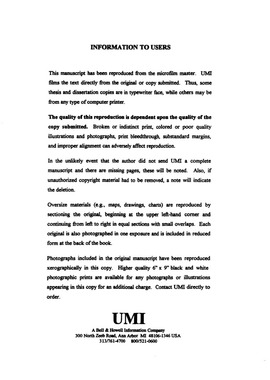| dc.contributor.advisor | Wallace, Linda L., | en_US |
| dc.contributor.author | Gropp, Robert Edward. | en_US |
| dc.date.accessioned | 2013-08-16T12:29:50Z | |
| dc.date.available | 2013-08-16T12:29:50Z | |
| dc.date.issued | 1997 | en_US |
| dc.identifier.uri | https://hdl.handle.net/11244/5529 | |
| dc.description.abstract | Depending upon the parameter and scale of measurement, evidence for each model exists. Further studies of "natural" resource and disturbance regimes (e.g, fire, urine patches, grazing) with greater temporal complexity are required to determine under what circumstances each model is appropriate in this system. | en_US |
| dc.description.abstract | Chapter I is a greenhouse study designed to address the physiological (gas exchange), morphological (height, tiller and circumference growth rates), and biomass responses of two dominant grasses (Andropogon gerardii and Panicum virgatum) to nitrogen availability (0.01, 0.1, 1.0 and 10.0 mM nitrate) and disturbance (simulated bison grazing). The experiment was fully crossed. Species responses to these treatments were mixed. Nitrogen availability most strongly affected the above parameters for P. virgatum. The responses of A. gerardii, however, were regulated by disturbance. These species responses provide support for both competition models and indicate that a single model may not explain interspecific interactions in this system. | en_US |
| dc.description.abstract | The resource ratio and plant strategies models of plant competition were empirically tested in a greenhouse (Chapter I) and a field study (Chapter II) conducted in the tallgrass prairie of Oklahoma. The resource ratio model predicts that a competitively superior species is one with the ability to acquire limiting vital resources at levels lower than neighboring species. Species with this capability should dominate the community at the expense of competitively inferior species. The plant strategies hypothesis, however, asserts that competitively dominant species are those with the capacity to acquire resources in the presence of moderate disturbances (e.g. grazing) and that community structure will reflect a systems disturbance and resource regime. | en_US |
| dc.description.abstract | Chapter II concerns a field study designed to expand on the findings of the greenhouse study. A fully crossed experiment manipulating light (ambient or 50% shade), nitrogen (bovine urine) and clipping was conducted 30 km south of Norman, Oklahoma. Community structure (species diversity, richness and evenness), plant and soil N, and productivity were measured during 1995 and 1996. Community diversity indices were significantly affected by time (intra- and inter-annually), urine and clipping. Clipping reduced species diversity and evenness. Urine and shade reduced species diversity and richness throughout the duration of the experiment. Detrended correspondence analysis showed clipping to be the strongest influence upon community structure indices; collapsing treatment plots in ordination space. Community structure results support the resource ratio model. Nitrogen dynamics and productivity, however, were regulated by clipping. Hence, these parameters support the plant strategies model of competition. | en_US |
| dc.format.extent | xv, 88 leaves : | en_US |
| dc.subject | Plant competition. | en_US |
| dc.subject | Agriculture, Range Management. | en_US |
| dc.subject | Biology, Botany. | en_US |
| dc.subject | Prairie ecology. | en_US |
| dc.subject | Biology, Ecology. | en_US |
| dc.title | Plant competition theory: Empirical tests from the tallgrass prairie. | en_US |
| dc.type | Thesis | en_US |
| dc.thesis.degree | Ph.D. | en_US |
| dc.thesis.degreeDiscipline | Department of Microbiology and Plant Biology | en_US |
| dc.note | Adviser: Linda L. Wallace. | en_US |
| dc.note | Source: Dissertation Abstracts International, Volume: 58-08, Section: B, page: 4016. | en_US |
| ou.identifier | (UMI)AAI9806322 | en_US |
| ou.group | College of Arts and Sciences::Department of Microbiology and Plant Biology | |
